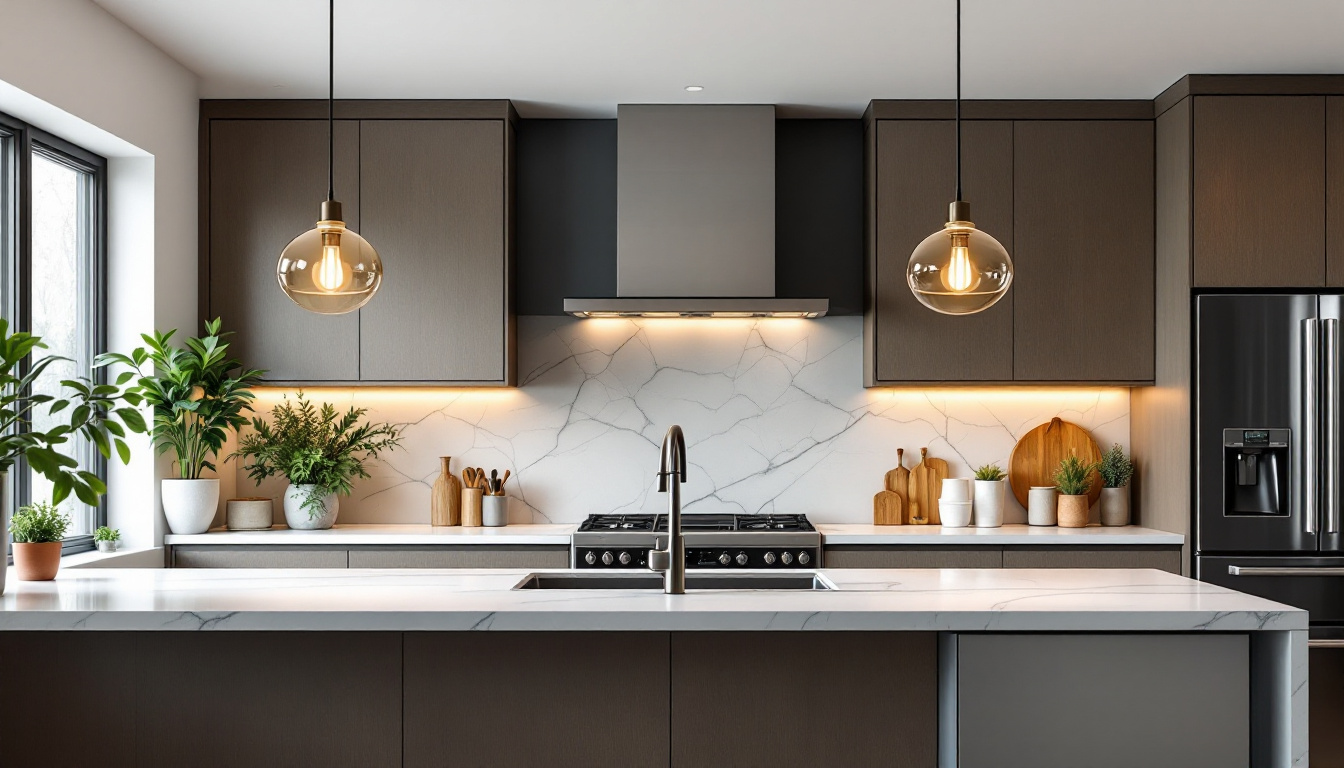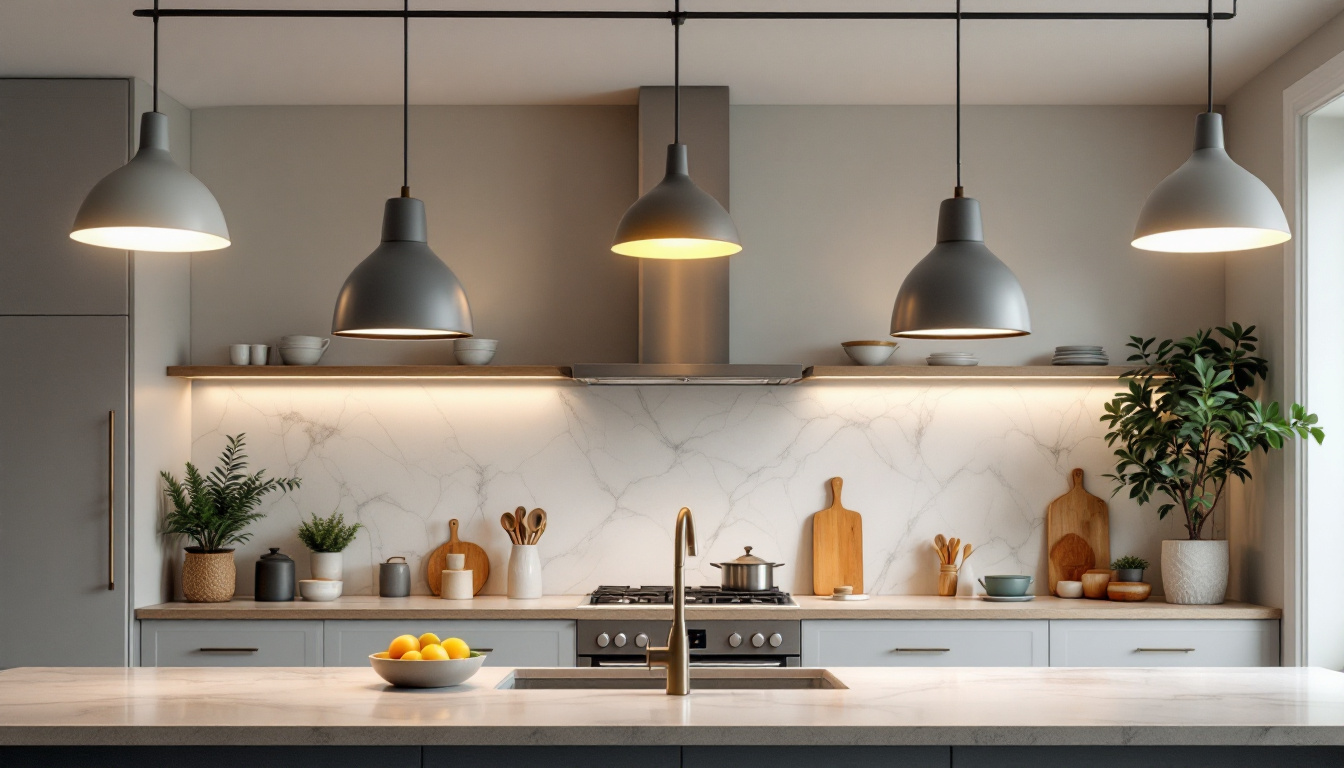
When it comes to kitchen design, lighting plays a pivotal role in creating an inviting and functional space. For lighting contractors, understanding how to effectively implement hanging lights in kitchens is essential. However, there are several common mistakes that can undermine the effectiveness of these installations. This article delves into these pitfalls, offering insights and solutions to help contractors enhance their lighting projects.
The layout of a kitchen significantly influences the choice and placement of hanging lights. One common mistake is failing to consider the overall design and flow of the space. A kitchen is often a hub of activity, and the lighting should complement the areas where tasks are performed, such as cooking, prepping, and dining.
Contractors should take the time to analyze the kitchen’s layout, including the placement of islands, countertops, and dining areas. This assessment will guide the selection of appropriate hanging lights, ensuring they are not only functional but also aesthetically pleasing. For instance, if the kitchen features a large island, a series of pendant lights can be hung above it to create a focal point while providing ample light for food preparation and casual dining. Additionally, the choice of light fixtures can reflect the overall theme of the kitchen, whether it be modern, rustic, or traditional, enhancing the visual appeal of the space.
Another frequent oversight is the installation height of hanging lights. Many contractors neglect to account for the height of the ceilings and the intended use of the space. Lights that are hung too low can obstruct views and create hazards, while those hung too high may fail to provide adequate illumination.
To avoid this mistake, it is crucial to maintain a standard height that allows for comfortable movement beneath the fixtures. A general rule of thumb is to hang pendant lights about 30 to 36 inches above the countertop or island surface. However, this can vary based on the overall design and the specific needs of the kitchen. For example, in a kitchen with higher ceilings, longer suspension cords may be necessary to maintain the right balance of light and space. Furthermore, considering the use of dimmable lighting options can add versatility, allowing homeowners to adjust the ambiance according to the time of day or occasion. This flexibility can transform a functional kitchen into a warm, inviting environment perfect for entertaining guests or enjoying family meals.
Choosing the right style of hanging lights is vital for achieving a cohesive look in the kitchen. Contractors often make the error of selecting fixtures that clash with the existing decor. It is essential to consider the overall theme of the kitchen, whether it be modern, rustic, or traditional.
Fixtures should harmonize with cabinetry, countertops, and other design elements. For instance, sleek, minimalist pendants may work well in a contemporary kitchen, while ornate chandeliers could enhance a more traditional space. Taking the time to match the lighting style with the kitchen’s aesthetic can elevate the entire design. Furthermore, incorporating unique materials—such as brushed brass or aged copper—can add an extra layer of sophistication. Consider how the finish of the fixtures will interact with other metallic elements in the kitchen, like cabinet handles or appliances, to create a unified look.
In addition, the scale of the fixtures is equally important. Large, statement-making pendants can serve as focal points, while smaller, clustered lights can create a more intimate setting. It’s crucial to ensure that the size of the fixtures is proportionate to the kitchen space; oversized lights in a small kitchen can feel overwhelming, while tiny fixtures in a spacious area may get lost. A well-thought-out arrangement can enhance the kitchen’s functionality and aesthetic appeal.
Another critical factor is the brightness and color temperature of the hanging lights. Many contractors overlook the importance of selecting bulbs that provide sufficient illumination for the kitchen’s tasks. Insufficient brightness can lead to a dim and uninviting atmosphere, while overly bright lights can create glare and discomfort.
Additionally, the color temperature of the bulbs plays a significant role in the kitchen’s ambiance. Warmer tones can create a cozy atmosphere, while cooler tones may enhance a more modern, clinical feel. Contractors should consider the activities that will take place in the kitchen and choose lighting that supports those needs. For example, if the kitchen is a hub for family gatherings and cooking, a warmer light can foster a welcoming environment, while brighter, cooler lights might be more suitable for precise tasks like chopping or baking.
Moreover, the use of dimmable fixtures can provide flexibility in lighting options, allowing homeowners to adjust the brightness based on the time of day or the occasion. This adaptability can transform the kitchen from a bustling workspace during meal prep to a soft-lit dining area for intimate dinners. By thoughtfully selecting the right brightness and color temperature, contractors can significantly enhance both the functionality and the mood of the kitchen space.
The placement of hanging lights is crucial for both functionality and aesthetics. A common mistake is clustering lights too closely together or spacing them unevenly. This can lead to areas of the kitchen being poorly lit or overly illuminated, creating an unbalanced look.
To achieve optimal lighting, contractors should develop a plan that outlines the positioning of each fixture. This plan should take into account the size of the kitchen, the layout, and the specific functions of each area. A well-thought-out arrangement can enhance the overall design while ensuring adequate lighting for all tasks. For example, placing lights directly above an island can create a focal point, making it an inviting space for family gatherings or meal preparation. Additionally, considering the height at which the fixtures are hung is vital; too low, and they may obstruct views or become hazards, while too high can diminish their effectiveness.
Task lighting is essential in a kitchen, particularly in areas where precision is required, such as over countertops and cooking surfaces. Unfortunately, many contractors neglect to incorporate adequate task lighting when installing hanging fixtures. This oversight can lead to frustration for homeowners who find it difficult to perform everyday tasks.
To rectify this, contractors should consider integrating additional task lighting solutions, such as under-cabinet lights or adjustable fixtures, alongside hanging lights. This layered approach not only enhances functionality but also adds depth and interest to the kitchen’s lighting design. For instance, LED strip lights under cabinets can provide a warm glow that illuminates work surfaces without harsh shadows, making food preparation safer and more enjoyable. Moreover, dimmable options for task lighting can allow homeowners to adjust the brightness according to the time of day or the mood they wish to create, further enhancing the kitchen’s versatility.
Electrical considerations are paramount when installing hanging lights. A common mistake is underestimating the load capacity of existing wiring. Overloading circuits can lead to safety hazards and potential electrical failures. Contractors must ensure that the wiring is adequate to support the weight and electrical requirements of the chosen fixtures.
Before installation, it is advisable to conduct a thorough evaluation of the electrical system. This includes checking the amperage and ensuring that the circuit can handle the additional load from the new lighting fixtures. If necessary, upgrades should be made to accommodate the new installations safely.
Switch placement is another critical aspect that is often overlooked. Many contractors fail to consider the convenience of switch locations in relation to the hanging lights. Poorly placed switches can lead to frustration for homeowners, who may find it inconvenient to control the lighting.
To avoid this issue, contractors should plan the placement of switches in accessible locations that allow for easy control of the hanging lights. This might involve installing dimmer switches to provide flexibility in lighting levels, enhancing both functionality and ambiance.
Hanging lights in kitchens can accumulate dust, grease, and grime over time. A common mistake is selecting fixtures that are difficult to clean or maintain. Contractors should consider the materials and designs of the lights, opting for those that can be easily wiped down or disassembled for thorough cleaning.
Fixtures with intricate designs may look stunning but can be challenging to maintain. Choosing simpler designs or materials that resist staining can save homeowners time and effort in upkeep, ensuring that the lights remain beautiful and functional for years to come.
Another maintenance-related consideration is the accessibility of bulbs for replacement. Many contractors overlook this aspect, leading to frustration for homeowners when it comes time to change bulbs. Fixtures that are too high or complicated to reach can deter homeowners from maintaining their lighting effectively.
Contractors should ensure that hanging lights are installed at a height that allows for easy access to bulbs. Additionally, selecting fixtures with user-friendly designs can enhance the overall experience for homeowners, making it easier for them to keep their kitchens well-lit.
In conclusion, the installation of kitchen hanging lights requires careful consideration and attention to detail. By avoiding common mistakes related to layout, fixture selection, placement, electrical considerations, and maintenance, lighting contractors can significantly enhance the quality and effectiveness of their installations. Understanding the unique dynamics of kitchen spaces and tailoring lighting solutions accordingly will lead to satisfied clients and successful projects.
Ultimately, the goal is to create a well-lit, functional, and aesthetically pleasing kitchen that meets the needs of homeowners. By taking the time to address these common pitfalls, contractors can elevate their work and contribute to the overall success of kitchen designs.
Ready to avoid the common pitfalls of kitchen lighting installations and impress your clients with stunning results? Choose LumenWholesale for your lighting needs and gain access to a vast selection of top-quality, spec-grade lighting products at unbeatable wholesale prices. Our commitment to quality, affordability, and convenience ensures that you can provide the best lighting solutions without the hassle of inflated markups or hidden fees. Plus, with free shipping on bulk orders, you can stock up on premium lighting with ease. Elevate your lighting projects today by visiting Wholesale Lighting at the Best Value and experience the LumenWholesale difference.

Discover the importance of the 3 gang blank plate in modern lighting projects.

Discover the essential guide for lighting contractors on selecting the perfect cable puller tool.

Discover the essentials of kitchen ceiling light fixtures in just five minutes.

Discover how LED light walls can transform your business as a lighting contractor.